Mobile Measurement of PM2.5 Based on an Individual in Ulaanbaatar City
Abstract
1. Introduction
2. Materials and Methods
2.1. Study Area
2.2. Study Object
2.3. Portable Monitoring Solution
2.4. Data Collection, Extraction, and Processing
2.5. Data Analysis
3. Results
3.1. PM2.5 Concentration in the Wintertime
3.2. Personal Exposure and Dose
4. Discussion
4.1. PM2.5 Concentration in Various Microenvironments
4.2. Time–Activity Pattern of the Participant
4.3. Study Limitations
5. Conclusions
- The data were collected from 1 October 2018, to 31 December 2018, and the participant spent most of her time indoors. In the microenvironments, the average PM2.5 levels were 19.50 ± 32.26 µg/m3 at home, 30.64 ± 36.55 µg/m3 at the house, 26.24 ± 33.98 µg/m3 at the NUM, 42.87 ± 36.17 µg/m3 in public transportion, and 55.73 ± 84.79 µg/m3 at the restaurant, respectively;
- We estimated the exposure of PM2.5 for selected days. The maximum level of exposure occurred on 4 November 2018. According to the measurements of the day, the participant inhaled the maximum amount of PM2.5 from 09:00 to 11:00;
- The PM2.5 concentration increased because of traffic congestion and burning coal at the time of starting and finishing work. In addition, the fact that road and the street are swept at that time is another reason behind the increasing concentration of PM2.5. In order to diminish individual exposure and reduce the conjunction of events, the street or road should be swept at another time.
Author Contributions
Funding
Acknowledgments
Conflicts of Interest
References
- Health Effects Institute. State of Global Air 2019; Special Report; Health Effects Institute: Boston, MA, USA, 2019; ISSN 2578-6873. [Google Scholar]
- World Health Organization. Air Pollution 2018. Available online: https://www.who.int/health-topics/air-pollution/ (accessed on 15 February 2019).
- Smith, K.R.; Pillarisetti, A. Household Air Pollution from Solid Cookfuels and Health. In Disease Control Priorities, 3rd ed.; Mock, C.N., Kobusingye, O., Nugent, R., Smith, K., Eds.; World Bank Press: Washington, DC, USA, 2017; Volume 9, p. 133. ISBN 978-1-4648-0527-1. [Google Scholar]
- Xing, Y.F.; Xu, Y.H.; Shi, M.H.; Lian, Y.X. The impact of PM2.5 on the human respiratory system. J. Thorac. Dis. 2016, 8, 69. [Google Scholar] [CrossRef]
- Vedal, S. Ambient particles and health: Lines that divide. J. Air Waste Manag. Assoc. 1997, 47, 551–581. [Google Scholar] [CrossRef] [PubMed]
- Huang, X.H.; Bian, Q.; Ng, W.M.; Louie, P.K.; Yu, J.Z. Characterization of PM2.5 major components and source investigation in suburban Hong Kong: A one-year monitoring study. Aerosol Air Qual. Res. 2014, 14, 237–250. [Google Scholar] [CrossRef]
- Samet, J.M.; Dominici, F.; Curriero, F.C.; Coursac, I.; Zeger, S.L. Fine particulate air pollution and mortality in 20 US cities, 1987–1994. N. Engl. J. Med. 2000, 343, 1742–1749. [Google Scholar] [CrossRef]
- Künzli, N.; Jerrett, M.; Mack, W.J.; Beckerman, B.; LaBree, L.; Gilliland, F.; Thomas, D.; Peters, J.; Hodis, H.N. Ambient air pollution and atherosclerosis in Los Angeles. Environ. Health Perspect. 2004, 113, 201–206. [Google Scholar] [CrossRef]
- Nelin, T.D.; Joseph, A.M.; Gorr, M.W.; Wold, L.E. Direct and indirect effects of particulate matter on the cardiovascular system. Toxicol. Lett. 2012, 208, 293–299. [Google Scholar] [CrossRef]
- Millman, A.; Tang, D.; Perera, F.P. Air pollution threatens the health of children in China. Pediatrics 2008, 122, 620–628. [Google Scholar] [CrossRef]
- Mongolia: Heating Stove Market Trends in Poor, Peri-Urban ger Areas of Ulaanbaatar and Selected Markets outside Ulaanbaatar: With Generous Support from the Australian Government; The World Bank Group: Washington, DC, USA, 2011; p. 87052.
- Mongolian National Statistics Committee. Available online: www.1212.mn/ (accessed on 22 March 2019).
- Guttikunda, S. Urban Air Pollution Analysis for Ulaanbaatar; Elsevier: Washington, DC, USA, 2007. [Google Scholar]
- Laragh, G.; Maria, G.T.; Kidist, K.B. Air pollution in Mongolia. Bull. World Health Organ. 2019, 97, 79–80. [Google Scholar] [CrossRef]
- Chimedsuren, O.; Smith, K.R. Report of Urban Air Pollution Impacts on the Health of Population; Press: Ulaanbaatar, Mongolia, 2014. [Google Scholar]
- Buckley, T.J.; Waldman, J.M.; Freeman, N.C.; Lioy, P.J.; Marple, V.A.; Turner, W.A. Calibration, intersampler comparison, and field application of a new PM10 personal air-sampling impactor. Aerosol Sci. Technol. 1991, 14, 380–387. [Google Scholar] [CrossRef]
- Suh, H.H.; Zanobetti, A. Exposure error masks the relationship between traffic-related air pollution and heart rate variability (HRV). J. Occup. Environ. Med./Am. Coll. Occup. Environ. Med. 2010, 52, 685. [Google Scholar] [CrossRef]
- Janssen, N.A.; de Hartog, J.J.; Hoek, G.; Brunekreef, B.; Lanki, T.; Timonen, K.L.; Pekkanen, J. Personal exposure to fine particulate matter in elderly subjects: Relation between personal, indoor, and outdoor concentrations. J. Air Waste Manag. Assoc. 2000, 50, 1133–1143. [Google Scholar] [CrossRef] [PubMed]
- Janssen, N.A.; Hoek, G.; Harssema, H.; Brunekreef, B. Childhood exposure to PM10: Relation between personal, classroom, and outdoor concentrations. Occup. Environ. Med. 1997, 54, 888–894. [Google Scholar] [CrossRef]
- Meng, Q.Y.; Turpin, B.J.; Korn, L.; Weisel, C.P.; Morandi, M.; Colome, S.; Zhang, J.; Stock, T.; Spektor, D.; Winer, A.; et al. Influence of ambient (outdoor) sources on residential indoor and personal PM2.5 concentrations: Analyses of RIOPA data. J. Expo. Sci. Environ. Epidemiol. 2005, 15, 17. [Google Scholar] [CrossRef] [PubMed]
- Smith, K.R.; Samet, J.M.; Romieu, I.; Bruce, N. Indoor air pollution in developing countries and acute lower respiratory infections in children. Thorax 2000, 55, 518–532. [Google Scholar] [CrossRef] [PubMed]
- Cattaneo, A.; Taronna, M.; Garramone, G.; Peruzzo, C.; Schlitt, C.; Consonni, D.; Cavallo, D.M. Comparison between Personal and Individual Exposure to Urban Air Pollutants. Aerosol Sci. Technol. 2010, 44, 370–379. [Google Scholar] [CrossRef]
- Greaves, S.; Issarayangyun, T.; Liu, Q. Exploring variability in pedestrian exposure to fine particulates (PM2.5) along a busy road. Atmos. Environ. 2008, 42, 1665–1676. [Google Scholar] [CrossRef]
- Gulliver, J.; Briggs, D.J. Personal exposure to particulate air pollution in transport microenvironments. Atmos. Environ. 2004, 38, 1–8. [Google Scholar] [CrossRef]
- National Research Council. Strategies to Protect the Health of Deployed U.S. Forces: Detecting, Characterizing, and Documenting Exposures; National Academies Press: Washington, DC, USA, 2000; ISBN 0-309-06875-4. [Google Scholar]
- Watson, A.Y.; Bates, R.R.; Kennedy, D. Air Pollution, the Automobile, and Public Health; National Academies Press: Washington, DC, USA, 1988; Part II; pp. 207–238. ISBN 978-0-309-03726-6. [Google Scholar]
- Steinle, S.; Reis, S.; Sabel, C.E.; Semple, S.; Twigg, M.M.; Braban, C.F.; Leeson, S.R.; Heal, M.R.; Harrison, D.; Lin, C.; et al. Personal exposure monitoring of PM2.5 in indoor and outdoor microenvironments. Sci. Total Environ. 2015, 508, 383–394. [Google Scholar] [CrossRef]
- Broich, A.V.; Gerharz, L.E.; Klemm, O. Personal monitoring of exposure to particulate matter with a high temporal resolution. Environ. Sci. Pollut. Res. 2012, 19, 2959–2972. [Google Scholar] [CrossRef]
- American Time Use Survey. Time Use on an Average Weekday for Full-time University and College Students U.S. Bureau of Labor Statistics. 2015. Available online: https://www.bls.gov/tus/charts/students.html (accessed on 16 September 2019).
- Nakayama, T.; Matsumi, Y.; Kawahito, K.; Watabe, Y. Development and evaluation of a palm-sized optical PM2.5 sensor. Aerosol Sci. Technol. 2018, 52, 2–12. [Google Scholar] [CrossRef]
- Moya, J.; Phillips, l.; Schuda, L.; Wood, P.; Diaz, A.; Lee, R.; Clickner, R.; Birch, R.J.; Adjei, N.; Blood, P.; et al. Exposure Factors Handbook 2011 Edition; United States Environmental Protection Agency: Washington, DC, USA, 2011; Chapter 6; pp. 3–4. EPA/600/R-09/052F.
- Mongolian Air Quality Standard (MNS 4585:2016). Available online: http://www.agaar.mn/article-view/546 (accessed on 12 March 2018).
- Louis, G.D.; Damstra, T.; Park, T.; Potosi, S.L.; Faustman, E.; Hass, U.; Kavlock, R.; Park, T.; Kimmel, C.; Kimmel, G.; et al. Principles for Evaluating Health Risks in Children Associated with Exposure to Chemicals; WHO Press: Geneva, Switzerland, 2006; Chapter 5; p. 134. ISBN 978-92-4-157237-8. [Google Scholar]
- Cohen Hubal, E.A.; Sheldon, L.S.; Burke, J.M.; McCurdy, T.R.; Berry, M.R.; Rigas, M.L.; Zartarian, V.G.; Freeman, N.C. Children’s exposure assessment: A review of factors influencing Children’s exposure, and the data available to characterize and assess that exposure. Environ. Health Perspect. 2000, 108, 475–486. [Google Scholar] [CrossRef] [PubMed]
- Klepeis, N.E.; Nelson, W.C.; Ott, W.R.; Robinson, J.P.; Tsang, A.M.; Switzer, P.; Behar, J.V.; Hern, S.C.; Engelmann, W.H. The National Human Activity Pattern Survey (NHAPS): A resource for assessing exposure to environmental pollutants. J. Expo. Anal. Environ. Epidemiol. 2001, 11, 231–252. [Google Scholar] [CrossRef]
- World Health Organization. Air Quality Guidelines for Particulate Matter, Ozone, Nitrogen Dioxide and Sulfur Dioxide; WHO Press: Geneva, Switzerland, 2005; pp. 8–13. [Google Scholar]
- Lim, M.; Myagmarchuluun, S.; Ban, H.; Hwang, Y.; Ochir, C.; Lodoisamba, D.; Lee, K. Characteristics of Indoor PM2.5 Concentration in Gers Using Coal Stoves in Ulaanbaatar, Mongolia. Int. J. Environ. Res. Public Health 2018, 15, 2524. [Google Scholar] [CrossRef] [PubMed]
- Abt, E.; Suh, H.H.; Allen, G.; Koutrakis, P. Characterization of indoor particle sources: A study conducted in the metropolitan Boston area. Environ. Health Perspect. 2000, 108, 35–44. [Google Scholar] [CrossRef] [PubMed]
- Monn, C.H.; Fuchs, A.; Högger, D.; Junker, M.; Kogelschatz, D.; Roth, N.; Wanner, H.U. Particulate matter less than 10 μm (PM10) and fine particles less than 2.5 μm (PM2.5): Relationships between indoor, outdoor and personal concentrations. Sci. Total Environ. 1997, 208, 15–21. [Google Scholar] [CrossRef]
- Tucker, W.G. An overview of PM2.5 sources and control strategies. Fuel Process. Technol. 2000, 65, 379–392. [Google Scholar] [CrossRef]
- He, C.; Morawska, L.; Hitchins, J.; Gilbert, D. Contribution from indoor sources to particle number and mass concentrations in residential houses. Atmos. Environ. 2004, 38, 3405–3415. [Google Scholar] [CrossRef]
- Byambatseren, C.; Sonomdagva, C.; Michidmaa, N.; Yutaka, M. The Study of Outdoor and Indoor Ambient PM2.5 in Ulaanbaatar City. Proc. Mong. Acad. Sci. 2018, 58, 40–53. [Google Scholar] [CrossRef][Green Version]
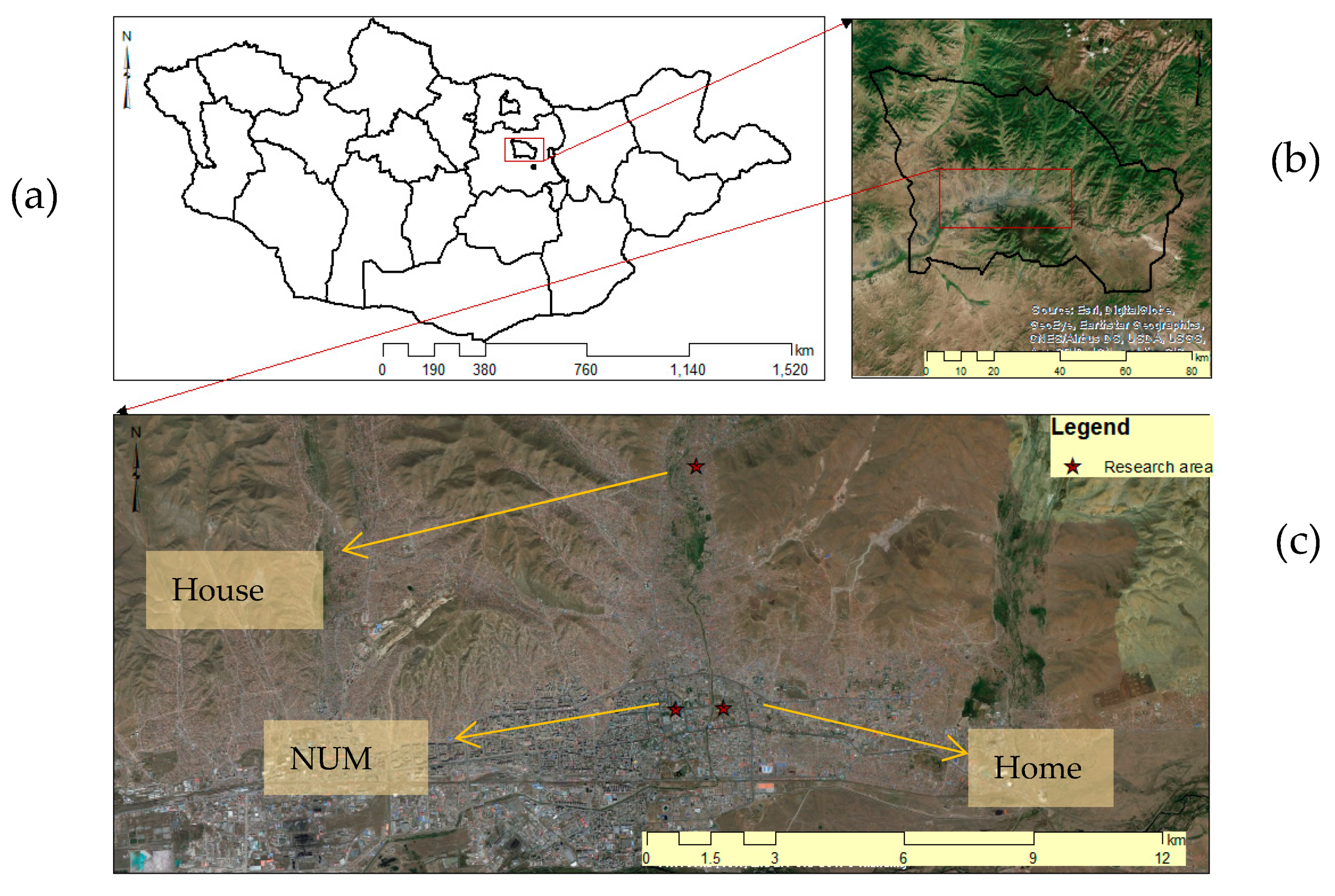
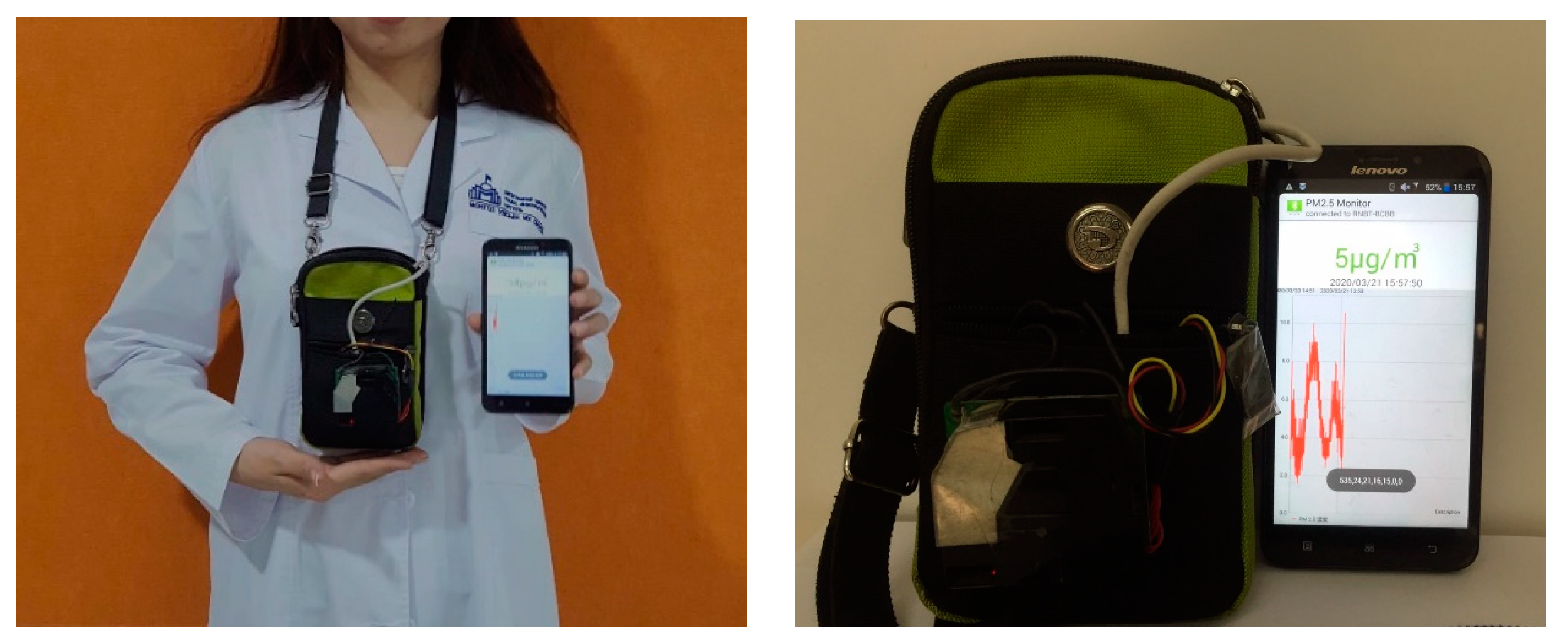

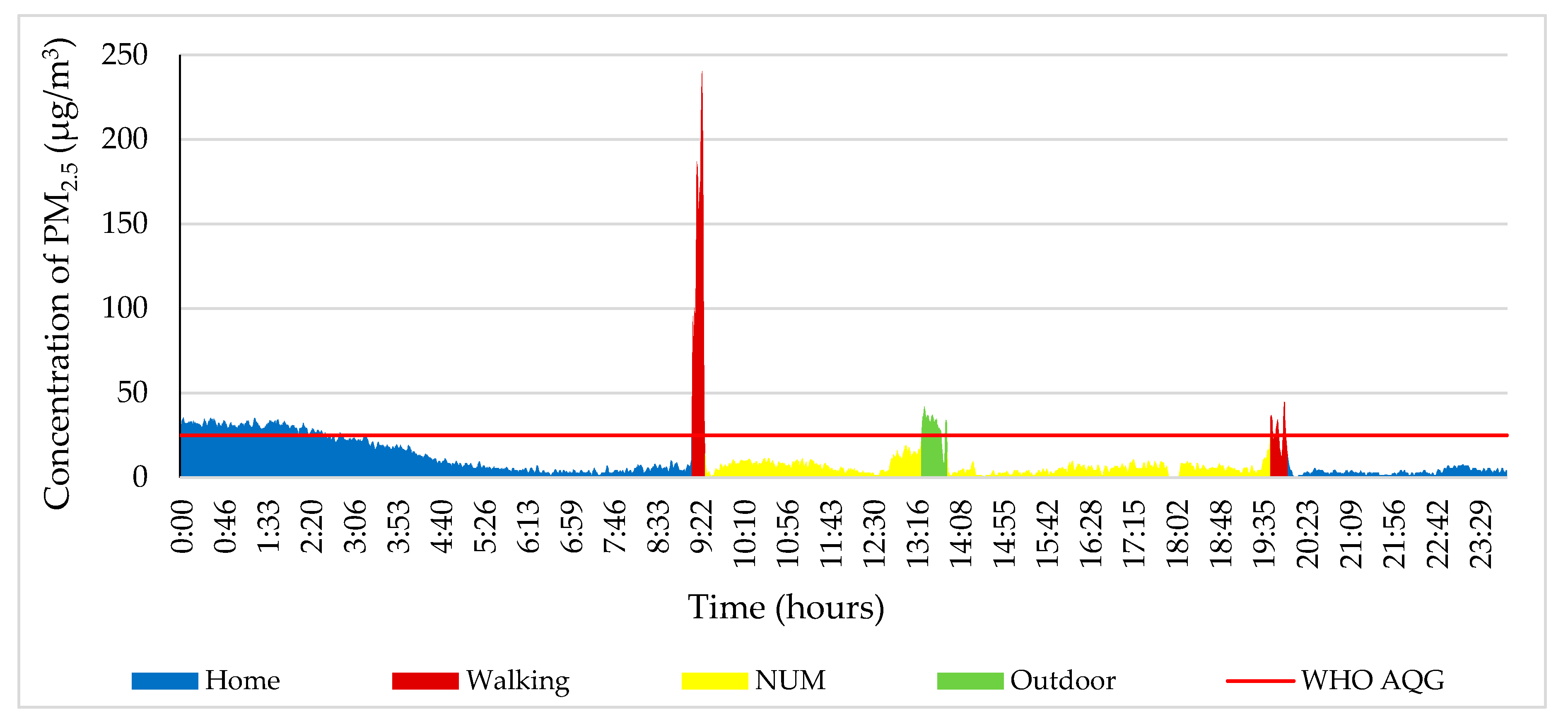
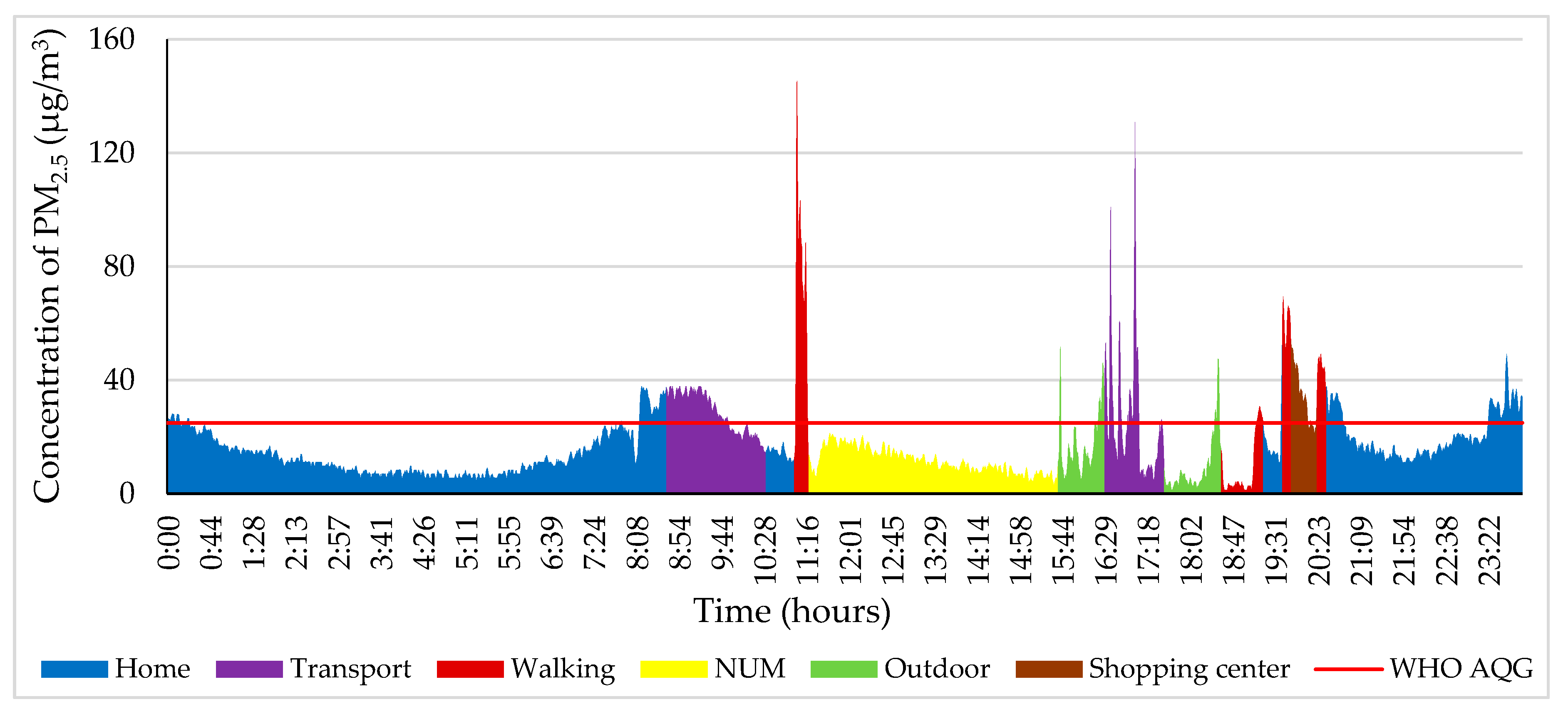
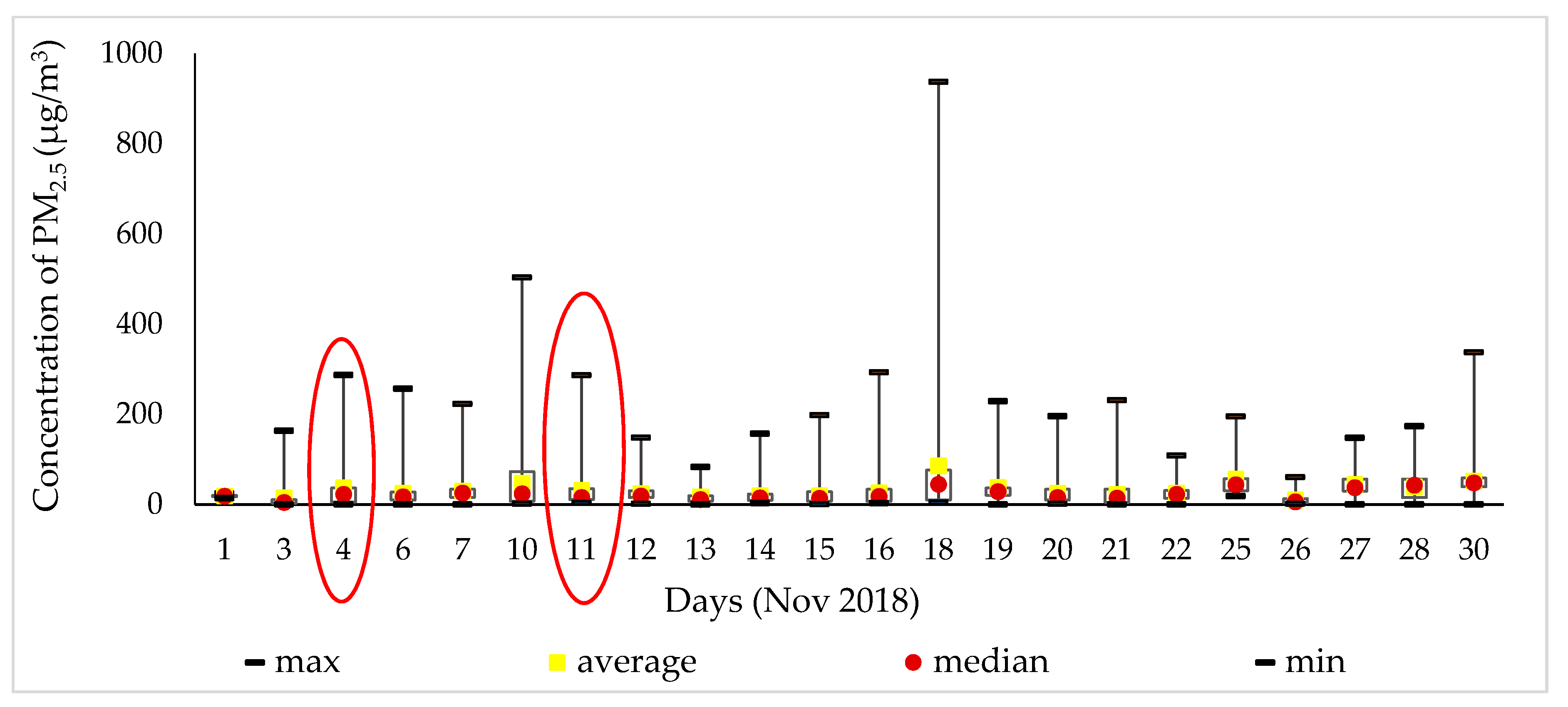

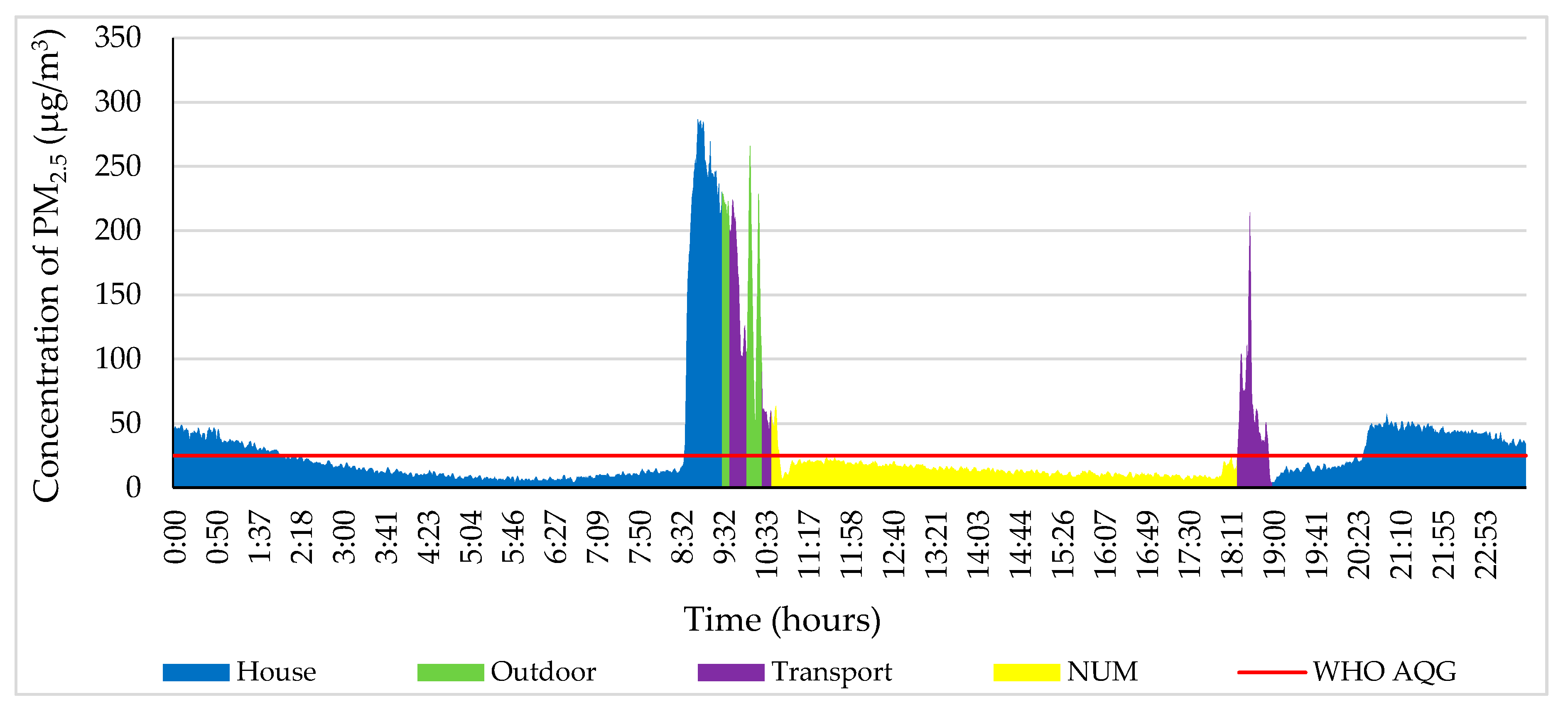
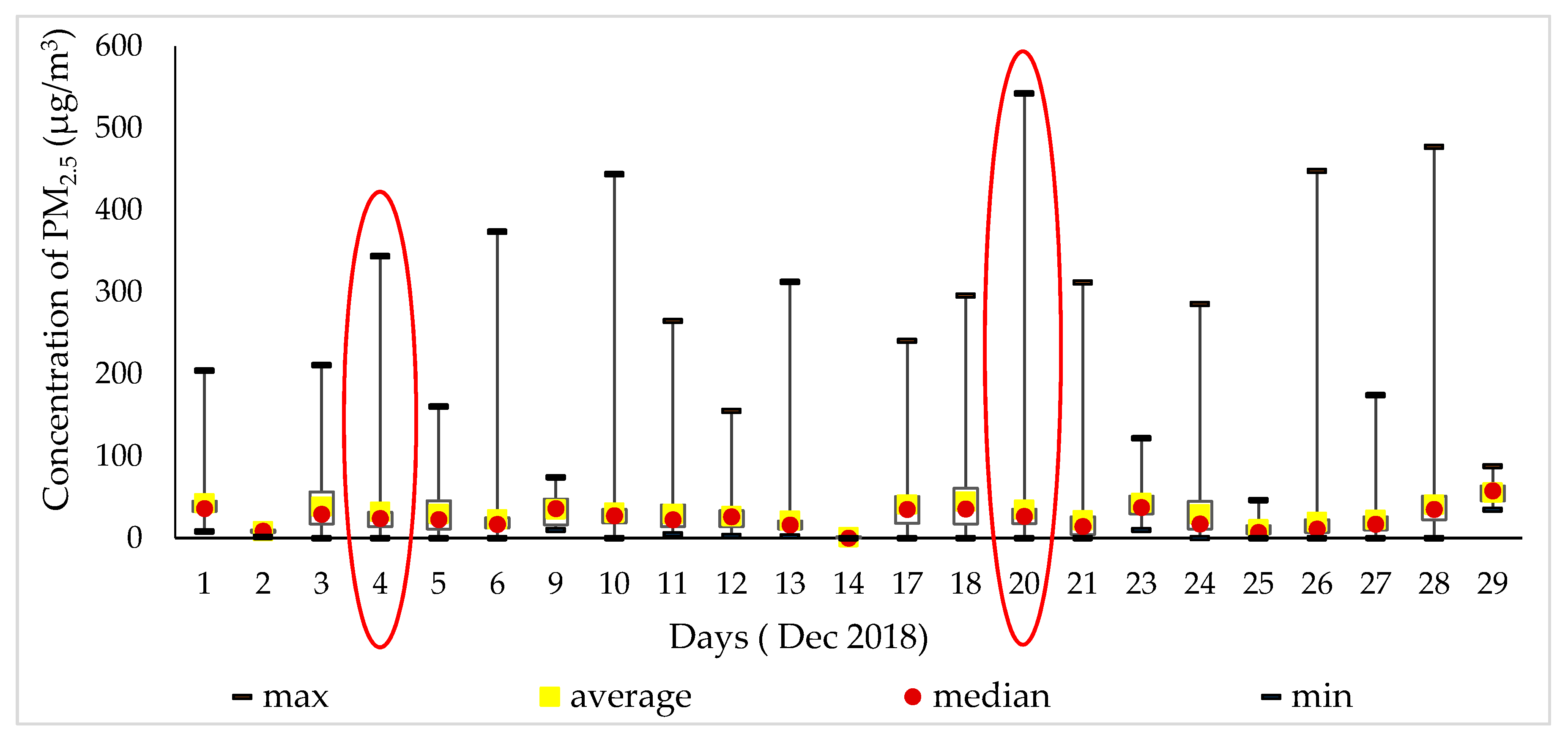
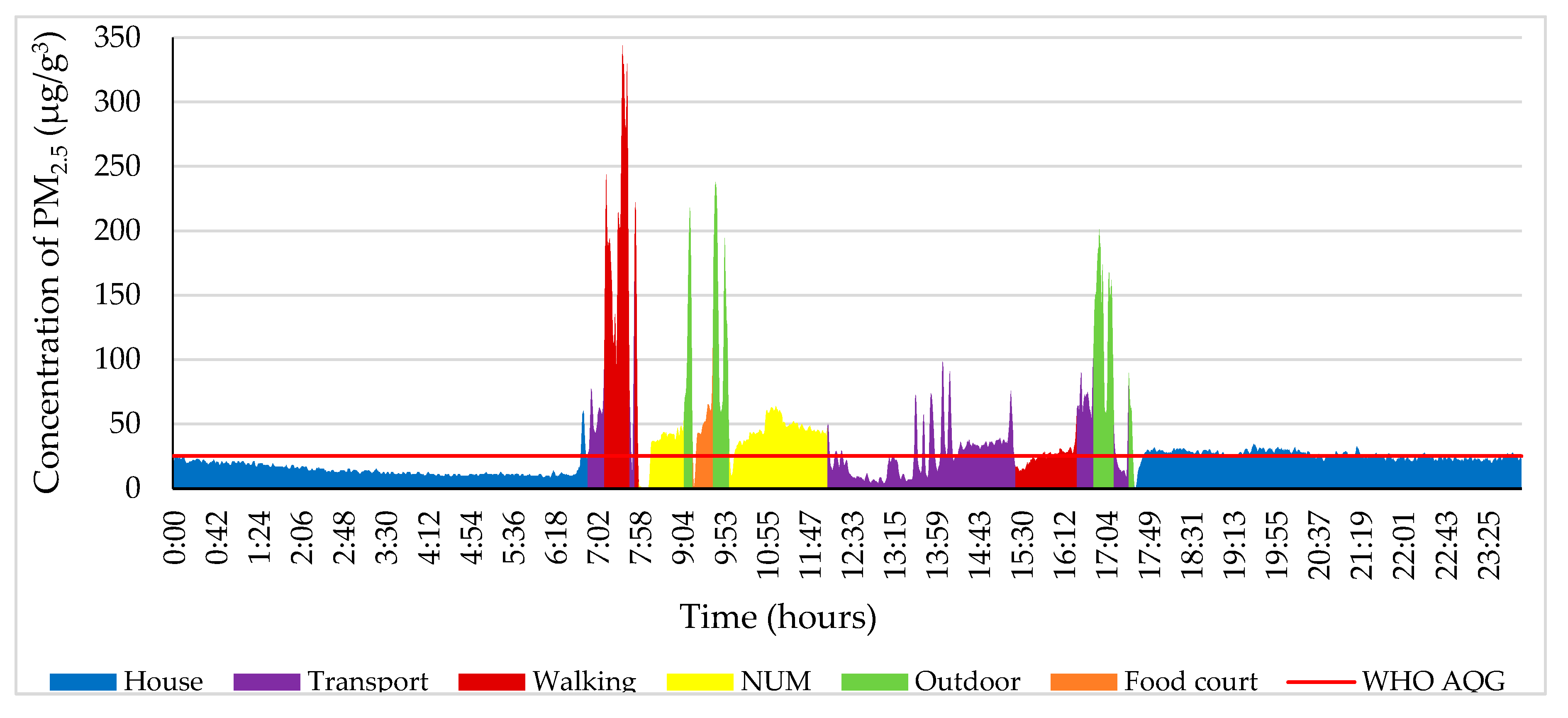

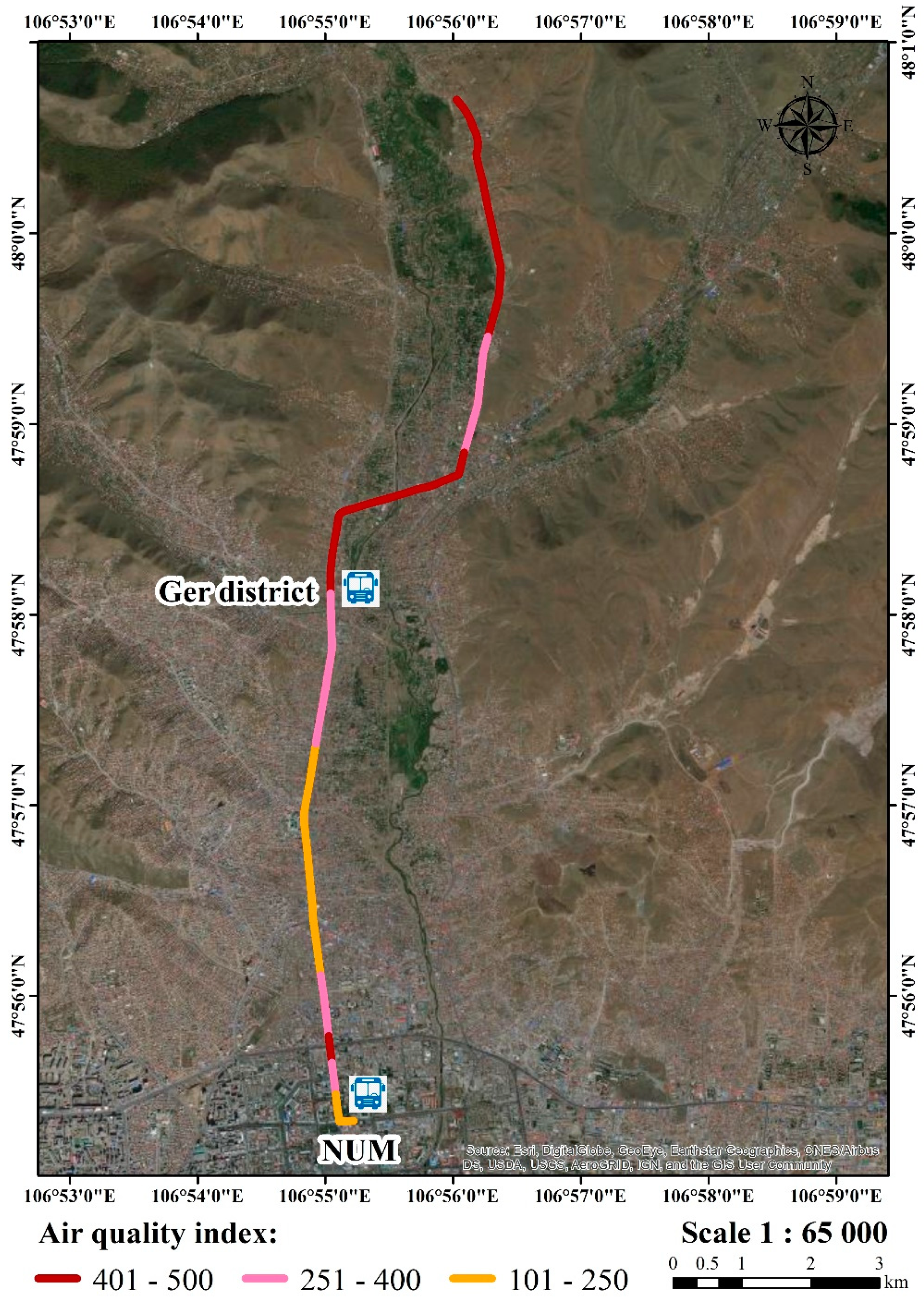
| Microenvironments | N | Maximum (µg/m3) | Minimum (µg/m3) | Mean (µg/m3) | SD (µg/m3) |
|---|---|---|---|---|---|
| Home | 17,031 | 407.10 | 0 | 19.50 | 32.26 |
| House | 42,821 | 503.58 | 0 | 30.64 | 36.55 |
| National University of Mongolia | 38,662 | 909.16 | 0 | 26.24 | 33.98 |
| Public Transportation | 3988 | 373.80 | 0.14 | 42.87 | 36.17 |
| Car | 2384 | 98.42 | 0 | 20.46 | 16.54 |
| Other Indoor | 1102 | 263.20 | 0 | 25.16 | 28.59 |
| Restaurant/Food Court/ | 1124 | 693.28 | 0 | 55.73 | 84.79 |
| Sport Center | 647 | 89.18 | 1.40 | 34.15 | 14.42 |
| Karaoke | 117 | 26.18 | 5.60 | 17.37 | 5.05 |
| Pub and Bar | 146 | 64.96 | 9.10 | 40.34 | 15.28 |
| Day | Doses in Various MEs (µg/m3) | |||||||
|---|---|---|---|---|---|---|---|---|
| Home | NUM | Means of Transportation | Outdoor | Shopping Center | Sport Center | Food Court | Sum of the Day | |
| 4 October 2018 | 4.20 | 5.20 | * | 17.30 | * | * | * | 158 |
| 9 October 2018 | 8.80 | 13.10 | 25.90 | 8.30 | 16.30 | * | * | 314.20 |
| 4 November 2018 | 24 | * | 93.70 | 102.20 | 13 | 29.20 | * | 769 |
| 11 November 2018 | 21 | 12.10 | 85.70 | 73.50 | * | * | * | 584 |
| 4 December 2018 | 11.10 | 39.10 | 27.70 | 76.60 | * | * | 34.80 | 637 |
| 20 December 2018 | 9.20 | 28.80 | 55.50 | 67.20 | * | * | 32.50 | 596.80 |
| 4 October 2018 | 9 October 2018 | 4 November 2018 | 11 November 2018 | 4 December 2018 | 20 December 2018 | |||||||
|---|---|---|---|---|---|---|---|---|---|---|---|---|
| Time | Concentration of PM2.5 (µg/m3) | Dose (µg/m3) | Concentration of PM2.5 (µg/m3) | Dose (µg/m3) | Concentration of PM2.5 (µg/m3) | Dose (µg/m3) | Concentration of PM2.5 (µg/m3) | Dose (µg/m3) | Concentration of PM2.5 (µg/m3) | Dose (µg/m3) | Concentration of PM2.5 (µg/m3) | Dose (µg/m3) |
| 0:00–0:59 | 32 | 9 | 23 | 7 | 9 | 3 | 44 | 13 | 21 | 6 | 42 | 13 |
| 1:00–1:59 | 31 | 9 | 15 | 4 | 6 | 2 | 32 | 10 | 18 | 5 | 36 | 11 |
| 2:00–2:59 | 26 | 8 | 11 | 3 | 5 | 1 | 21 | 6 | 14 | 4 | 32 | 9 |
| 3:00–3:59 | 20 | 6 | 8 | 2 | 5 | 1 | 14 | 4 | 12 | 4 | 26 | 8 |
| 4:00–4:59 | 12 | 3 | 7 | 2 | 4 | 1 | 10 | 3 | 11 | 3 | 22 | 6 |
| 5:00–5:59 | 6 | 2 | 7 | 2 | 4 | 1 | 7 | 2 | 11 | 3 | 17 | 5 |
| 6:00–6:59 | 4 | 1 | 10 | 3 | 4 | 1 | 7 | 2 | 19 | 6 | 15 | 4 |
| 7:00–7:59 | 3 | 3 | 19 | 16 | 9 | 8 | 10 | 9 | 142 | 124 | 18 | 16 |
| 8:00–8:59 | 6 | 5 | 31 | 27 | 42 | 37 | 76 | 66 | 30 | 26 | 104 | 91 |
| 9:00–9:59 | 39 | 34 | 31 | 27 | 237 | 207 | 216 | 189 | 88 | 77 | 19 | 17 |
| 10:00–10:59 | 9 | 8 | 17 | 15 | 166 | 145 | 81 | 71 | 39 | 34 | 15 | 13 |
| 11:00–11:59 | 7 | 6 | 31 | 27 | 57 | 50 | 20 | 18 | 50 | 44 | 85 | 74 |
| 12:00–12:59 | 5 | 4 | 16 | 14 | 36 | 32 | 18 | 16 | 17 | 15 | 39 | 34 |
| 13:00–13:59 | 22 | 20 | 11 | 10 | 34 | 30 | 15 | 13 | 21 | 18 | 22 | 19 |
| 14:00–14:59 | 3 | 3 | 9 | 8 | 32 | 28 | 13 | 11 | 36 | 31 | 61 | 53 |
| 15:00–15:59 | 3 | 3 | 9 | 8 | 34 | 29 | 11 | 10 | 28 | 24 | 45 | 39 |
| 16:00–16:59 | 6 | 5 | 25 | 22 | 47 | 41 | 10 | 9 | 63 | 55 | 31 | 27 |
| 17:00–17:59 | 6 | 5 | 15 | 13 | 29 | 25 | 8 | 7 | 45 | 39 | 24 | 21 |
| 18:00–18:59 | 6 | 5 | 9 | 7 | 27 | 23 | 47 | 41 | 29 | 25 | 14 | 13 |
| 19:00–19:59 | 12 | 10 | 26 | 23 | 91 | 79 | 14 | 12 | 28 | 25 | 30 | 26 |
| 20:00–20:59 | 4 | 4 | 33 | 28 | 52 | 45 | 32 | 28 | 27 | 23 | 68 | 60 |
| 21:00–21:59 | 2 | 2 | 15 | 13 | 28 | 24 | 47 | 41 | 25 | 22 | 44 | 38 |
| 22:00–22:59 | 3 | 1 | 16 | 5 | 27 | 8 | 43 | 13 | 23 | 7 | 32 | 9 |
| 23:00–23:59 | 5 | 2 | 28 | 8 | 20 | 6 | 37 | 11 | 23 | 7 | 28 | 8 |
| Numerical Values | Levels of Health Concern | Colors |
|---|---|---|
| When the AQI Is in This Range: | Air Quality Conditions Are: | As Symbolized by This Color: |
| 0–50 | Good | Green |
| 51–100 | Moderate | Yellow |
| 101–250 | Unhealthy for sensitive groups | Orange |
| 251–400 | Unhealthy | Pink |
| 401–500 | Very unhealthy | Maroon |
| +501 | Hazardous | Red |
© 2020 by the authors. Licensee MDPI, Basel, Switzerland. This article is an open access article distributed under the terms and conditions of the Creative Commons Attribution (CC BY) license (http://creativecommons.org/licenses/by/4.0/).
Share and Cite
Ariunsaikhan, A.; Chonokhuu, S.; Matsumi, Y. Mobile Measurement of PM2.5 Based on an Individual in Ulaanbaatar City. Int. J. Environ. Res. Public Health 2020, 17, 2701. https://doi.org/10.3390/ijerph17082701
Ariunsaikhan A, Chonokhuu S, Matsumi Y. Mobile Measurement of PM2.5 Based on an Individual in Ulaanbaatar City. International Journal of Environmental Research and Public Health. 2020; 17(8):2701. https://doi.org/10.3390/ijerph17082701
Chicago/Turabian StyleAriunsaikhan, Ariundelger, Sonomdagva Chonokhuu, and Yutaka Matsumi. 2020. "Mobile Measurement of PM2.5 Based on an Individual in Ulaanbaatar City" International Journal of Environmental Research and Public Health 17, no. 8: 2701. https://doi.org/10.3390/ijerph17082701
APA StyleAriunsaikhan, A., Chonokhuu, S., & Matsumi, Y. (2020). Mobile Measurement of PM2.5 Based on an Individual in Ulaanbaatar City. International Journal of Environmental Research and Public Health, 17(8), 2701. https://doi.org/10.3390/ijerph17082701





